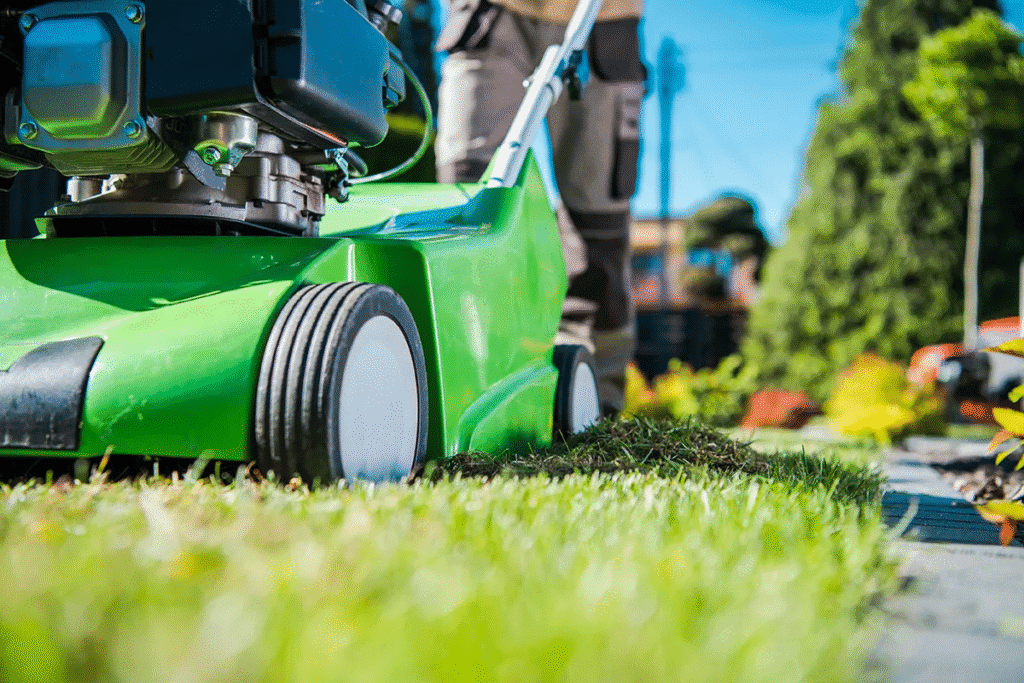Embarking on your lawn care journey can seem overwhelming at first. But don’t fret; we are here to assist you. Dream of a lawn that’ll make your neighbors jealous? This beginner’s guide has the simple advice you need. New homeowner or seasoned gardener? Transform your patchy, brown lawn into a thriving, verdant landscape. Lawn care success? Grow a lush, green yard with these simple tips.
Table of Contents:

- Understanding Your Soil: The Foundation of a Healthy Lawn
- Choosing the Right Grass: Not All Lawns Are Created Equal
- Mowing Mastery: The Key to a Tidy Lawn
- Watering Wisdom: Quenching Your Lawn’s Thirst
- Fertilizing for Success: Nourishing your lawn correctly makes all the difference. Feed it right!
- Weed Control: Keeping Invaders at Bay
- Dealing with Pests and Diseases
- Season al Lawn Care: Adapting to Nature’s Rhythm
- Tools of the Trade: Equipping Yourself for Success
- Conclusion
Understanding Your Soil: The Foundation of a Healthy Lawn
The health of your lawn truly begins with the soil. Knowing what’s in your soil is super important if you want healthy plants. Obtaining a soil test is the most effective way to learn what you are working with, revealing your soil’s pH levels and its current nutrient content.
Most types of grasses thrive in slightly acidic soil, ideally with a pH ranging from 6.0 to 7.0. If your soil test indicates it is too acidic or alkaline, your grass will struggle to absorb essential nutrients efficiently. To correct this, you might need to apply lime to raise the pH or sulfur to lower it, creating a more hospitable environment for grasses require.
Nutrient deficiencies in your soil? A simple soil test will reveal if your plants are getting what they need. Low levels of essential nutrients are easily identified. Choosing the correct fertilizer is easier with this information. It pinpoints exactly what your lawn requires. Just as we need balanced meals, your lawn needs the right nutrients. A tailored feeding program is the key to a vibrant, healthy lawn – it’s that simple. Knowing the organic matter percentage and salt levels organic matter can also guide soil amendment choices; for instance, clay soils benefit from organic matter to improve drainage and aeration, while sandy soils may need it to help retain water.

For a quick overview, try a home testing kit. If you need a really thorough analysis, send your samples to a soil testing lab. This detailed report will show basic nutritional, salt levels, and the organic matter percentage. Water absorption is hampered by excessive salt and organic matter; this is a frequent cause of lawn problems. Think of it like trying to water a plant in a pot full of rocks.
Choosing the Right Grass: Not All Lawns Are Created Equal
Selecting the appropriate grass type is a pivotal decision for your lawn’s success. It’s about more than just aesthetic appeal; you must consider your local climate, the amount of sunlight your yard receives daily, and the expected foot traffic. Planting grass seed of the wrong type can lead to ongoing struggles and a less-than-ideal lawn.
For cooler regions, cool-season grasses such as Kentucky bluegrass, fescue, or ryegrass are excellent choices as they are adapted to thrive when temperatures fall. If you reside in a warmer climate, warm-season grasses like Bermuda grass, Zoysia grass, or St. Augustine grass are more suitable, as these grasses grow actively during hotter months. Some warm-season grass varieties are particularly drought-tolerant once established, a great benefit for water wisely practices.
Do not hesitate to consider a blend of grass types. A well-chosen mix can result in a more resilient lawn that maintains its green lawn appearance for a longer portion of the year. It’s akin to assembling a “super-team” specifically for your yard’s conditions, offering better disease resistance and adaptability. Getting your soil ready is the most important step for a healthy lawn. Proper prep helps your grass seeds sprout and grow strong.
Mowing Mastery: The Key to a Tidy Lawn
Lawn mowing might appear to be a simple task, but there is a definite art to doing it correctly for a healthy lawn. The fundamental rule is to never remove more than one-third of the grass blade’s height during a single lawn mow session. Following this rule helps your grass thrive; it avoids damage and promotes growth. Adjusting mowing heights according to the grass type and season is also important.
Ensure your lawn mower blades are consistently sharp. Dull blades tear the grass rather than making a clean cut, leaving your lawn susceptible to lawn disease and pest infestations. It’s comparable to giving your grass a damaging haircut – neither attractive nor beneficial for its health. Different lawn mowers, like reel or rotary mowers, offer different cut qualities.
Vary your lawn mowing pattern each time you mow based on how the grass is growing. Preventing soil compaction lets the grass grow straight up. As an added benefit, it can give your lawn that professionally maintained, striped appearance that many homeowners admire.
Watering Wisdom: Quenching Your Lawn’s Thirst

When it comes to watering your lawn, a strategy of less frequent but deeper watering sessions is generally most effective. Drought-resistant lawns are easier to grow with this technique; it encourages deep root growth. Aim to provide approximately one inch of water per week, factoring in any rainfall your area receives; good watering is essential.
The optimal time to water your lawn is early in the morning. Watering at this time allows the grass ample opportunity to dry before nightfall, significantly reducing the risk of fungal lawn diseases. Morning watering also minimizes water loss through evaporation due to lower temperatures and less wind, ensuring more water reaches the plant roots. Frequent watering, especially light and shallow, encourages shallow root growth, making the lawn less hardy.
Remember to adjust your watering schedule in accordance with the changing seasons and current weather conditions. Your lawn will naturally require less water during the cooler months and more substantial hydration during prolonged hot, dry spells. Watering your lawn? Get it right, or you could end up with root rot. Overwatering is just as bad as underwatering. The type of soil you have makes a big difference in how much water your grass needs. Sandy soil drains fast, while clay soil holds onto water.
Fertilizing for Success: Feeding Your Lawn Right
Feeding your lawn fertilizer is like giving it a supercharged vitamin. It gets the nutrients it needs to grow strong and look fantastic. The timing of fertilization really matters if you want to see the best effects. For cool-season grasses, the most advantageous times to fertilize are in the early spring and again in the fall. Warm-season grasses, on the other hand, benefit most from feedings administered from late spring through early fall.
Select a fertilizer based on the detailed results from your soil test. The three prominent numbers on a fertilizer bag (e.g., 10-10-10 or 24-0-6) represent the percentage ratio of nitrogen (N), phosphorus (P), and potassium (K), respectively. Think of macronutrients as the building blocks of a healthy lawn. Just like we need food to survive, grass needs these essential nutrients. Knowing the right amounts of each helps you keep your lawn looking its best.
It is very important not to over-fertilize your lawn. Too much fertilizer is bad news for your grass—it can get burned—and it’s also bad for the environment. Runoff from over-fertilized lawns contaminates our water. Always adhere strictly to the application rates and instructions provided on the fertilizer packaging. Remember, in fertilization, more is not always better for achieving a green lawn.
Weed Control: Keeping Invaders at Bay
A dense, vigorously growing, and healthy lawn is undoubtedly your most effective natural defense against invasive lawn weeds. However, even the most meticulously maintained lawns can occasionally experience issues with unwanted plant guests. Don’t let weeds take over. Get rid of them early on, before they have a chance to spread and ruin your beautiful lawn.
For minor weed problems or isolated lawn spots, hand-pulling is often the most environmentally friendly and effective solution, ensuring you remove the entire root. For really bad weeds, you might want to try herbicide. When choosing a chemical solution, always select products specifically formulated for use on lawns and the particular types of common lawn weeds you are targeting, such as broadleaf weeds, and follow the label instructions precisely to protect your existing grass.
Stopping weeds before they start is super important for a healthy lawn. Applying pre-emergent herbicides in early spring can stop weed seeds from germinating, effectively preventing many common lawn weeds from ever appearing. Proactive weed control is like preventative medicine for your lawn; it significantly minimizes future problems and saves you from having to treat individual weeds. This translates to less work for you and a healthier lawn.

Dealing with Pests and Diseases
Maintain a vigilant watch over your lawn for any early signs of trouble. See brown patches, wilting grass, or odd growth? That might mean you have pests or a lawn disease brewing. Catching problems early keeps small issues from becoming big headaches that wreck your whole lawn.
Not all insects in your yard are bad news. Lots of them are actually good for the ecosystem! Learn to differentiate between the “good guys” that might prey on pests and the troublemakers that cause damage. Encouraging natural predators, such as birds, by providing a suitable habitat can help naturally keep pest populations in check without resorting to chemicals.
If you determine that pesticides are necessary to address a pest problem, opt for products that are specifically targeted to the pests you are dealing with. Using broad-spectrum pesticides can accidentally kill helpful insects. This throws off the balance in your lawn’s ecosystem. Always adhere strictly to safety guidelines and application instructions when using any chemical treatments to protect yourself, your family, pets, and the environment from underlying issues these chemicals might cause.
Seasonal Lawn Care: Adapting to Nature’s Rhythm
Your lawn’s requirements for care change distinctly with the progression of the seasons. In the spring, your seasonal lawn care efforts should concentrate on cleaning up any accumulated winter debris, such as fallen leaves and twigs, and applying pre-emergent weed control to get ahead of weed seeds. Summer lawn care is primarily focused on proper lawn mowing techniques and adequate watering to help your grass combat heat stress and maintain its health.
Autumn is a particularly crucial period for lawn care activities that lay the groundwork for the following year. Get your lawn ready for winter. Overseeding fills in those thin areas, aeration helps the soil breathe, and fall fertilizer gives it the nutrients it needs. These steps meticulously prepare your lawn to endure the winter months and set the stage for lush, vibrant green growth when spring arrives. A lawn care schedule for each season is really useful.
During the winter, your lawn, especially cool-season grasses, might enter a dormant state, but this does not mean it should be completely ignored. It is advisable to avoid walking on frozen grass, as this can damage the crowns of the grass plants. Use this quieter period to reflect on your lawn care routine and plan your strategy for the upcoming growing season, considering any adjustments needed based on the previous year’s performance.
A helpful way to organize your seasonal lawn care is with a general guide:
| Season | Key Tasks | Notes |
|---|---|---|
| Early Spring | Clean-up, soil test, pre-emergent herbicide, first mow. | Wait until soil isn’t waterlogged. |
| Late Spring | Fertilize (cool-season kickstart, warm-season main feed), regular mowing, spot treat weeds. | Keep an eye out for lawn diseases early on. |
| Summer | Consistent mowing (possibly higher cut), deep watering, pest & disease monitoring. | Use water sparingly; droughts call for it. Avoid fertilizing cool-season grasses in high heat. |
| Early Fall | Aeration, overseeding (especially for cool-season grass), fertilize (crucial for cool-season grasses). | Best time for planting grass seed for many types. |
| Late Fall | Final mow (slightly shorter), winterizer fertilizer (for cool-season grasses), leaf removal. | Clean lawn mowers and tools before storage. |
| Winter | Minimize traffic on dormant/frozen lawn, plan for next year. | Ensure drainage to prevent ice buildup in lawn spots. |
Tools of the Trade: Equipping Yourself for Success
Having the appropriate tools at your disposal can make your lawn care tasks significantly easier and more effective. A good quality lawn mower is an essential investment; there are many lawn mowers to choose from. Consider opting for a mulching mower, which finely chops grass clippings and returns them to the soil, naturally recycling nutrients and adding organic matter.
For even fertilizer and seed distribution, use a spreader. Dethatching and leaf removal are easier with a sturdy rake. A sharp edger creates clean edges around walkways and flowerbeds. Always wear sturdy gloves to protect your hands and safety glasses to shield your eyes when using machinery or handling materials. Safety first!
Investing in tools like a soil moisture meter and pH test kits can remove much of the guesswork from your care routine. With these instruments, you can precisely measure soil moisture and pH. This helps you water efficiently and amend your soil as needed for optimal plant growth. For example, a low pH might indicate a need for lime. They are like having a mini lawn care laboratory readily available in your garage, helping you to maintain optimal soil conditions for a healthy, lawn lush with growth.

Conclusion
Mastering these lawn care tips for beginners is your direct path to achieving a beautiful, healthy, and resilient yard. Remember that creating a great lawn, one that makes your property lawn green and inviting, doesn’t happen instantaneously. Get ready to put in the hours—a thriving lawn demands consistent care. Be prepared to experiment; what works for one lawn might not work for yours. A great care plan and these tips will make you the envy of your neighbors. You’ll have the best lawn on the block! Happy gardening and successful planting grass seed endeavors.

